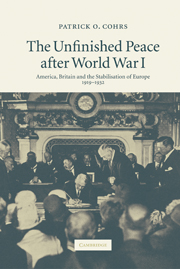Book contents
- Frontmatter
- Contents
- Acknowledgements
- List of abbreviations
- A note on the footnotes and bibliography
- Introduction
- Prologue
- 1 The wider challenges
- 2 Wilson, Lloyd George and the quest for a ‘peace to end all wars’
- 3 The ill-founded peace of 1919
- 4 The escalation of Europe's post-Versailles crisis, 1920–1923
- Part I The Anglo-American stabilisation of Europe, 1923–1924
- 5 Towards a Progressive transformation of European politics
- 6 Towards transatlantic co-operation and a new European order
- 7 The turning-point
- 8 From antagonism to accommodation
- 9 The two paths to the London conference
- 10 The first ‘real’ peace settlement after World War I
- Part II Europe's nascent Pax Anglo-Americana, 1924–1925
- Part III The unfinished transatlantic peace order: the system of London and Locarno, 1926–1929
- Epilogue
- Conclusion
- Map: Post-World War I Europe after the peace settlement of Versailles
- Bibliography
- Index
6 - Towards transatlantic co-operation and a new European order
The reorientation of British stabilisation policy, 1922–1924
Published online by Cambridge University Press: 21 July 2009
- Frontmatter
- Contents
- Acknowledgements
- List of abbreviations
- A note on the footnotes and bibliography
- Introduction
- Prologue
- 1 The wider challenges
- 2 Wilson, Lloyd George and the quest for a ‘peace to end all wars’
- 3 The ill-founded peace of 1919
- 4 The escalation of Europe's post-Versailles crisis, 1920–1923
- Part I The Anglo-American stabilisation of Europe, 1923–1924
- 5 Towards a Progressive transformation of European politics
- 6 Towards transatlantic co-operation and a new European order
- 7 The turning-point
- 8 From antagonism to accommodation
- 9 The two paths to the London conference
- 10 The first ‘real’ peace settlement after World War I
- Part II Europe's nascent Pax Anglo-Americana, 1924–1925
- Part III The unfinished transatlantic peace order: the system of London and Locarno, 1926–1929
- Epilogue
- Conclusion
- Map: Post-World War I Europe after the peace settlement of Versailles
- Bibliography
- Index
Summary
In the post-World War I era, Britain was not a status quo power, at least not in Europe. Yet numerous post-1945 studies on Britain's foreign relations in the 1920s have attempted to show just that: that Britain's core interest was to preserve the system of 1919, however imperfect it seemed, not least to British policymakers themselves. In the ‘realist’ view, the litmus test for British foreign policy became how far it could revive the only possible ‘axis of stability’ after America's withdrawal from Versailles – a fundamentally status quo-orientated entente with France that upheld Europe's balance of power against Germany's revisionist ambitions. Chiefly for economic reasons, yet also because of a flawed notion of ‘appeasement’, British leaders allegedly failed this test.
More recently, Britain's quest for postwar order has been placed – like America's – in an overarching continuity. Rather than forge alliances, Britain allegedly sought to ‘regulate’ Europe's status quo essentially by reviving, in key respects, the old European order of the nineteenth century. Further, it has been accentuated that British ‘appeasement’ was shaped by a corporatist ‘coalition’ akin to that in the United States, comprising the ruling policymaking elite, the City and the Bank of England under its influential governor Montagu Norman. Their common priority, it was claimed, was to preserve Britain's liberal-capitalist order, based on ‘free enterprise and the limited state’, against revolutionary tendencies in and outside the country.
- Type
- Chapter
- Information
- The Unfinished Peace after World War IAmerica, Britain and the Stabilisation of Europe, 1919–1932, pp. 90 - 99Publisher: Cambridge University PressPrint publication year: 2006



